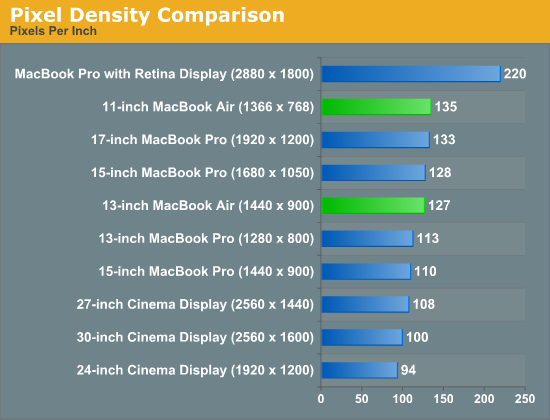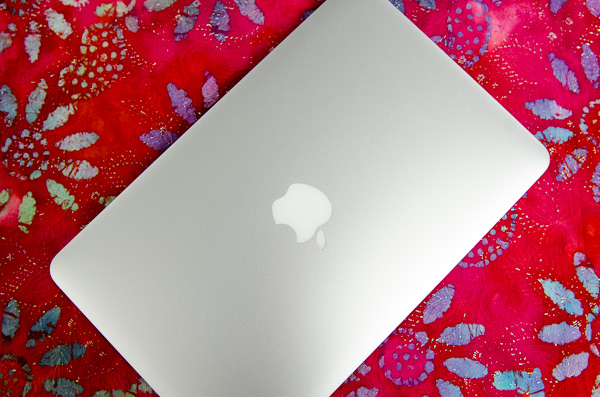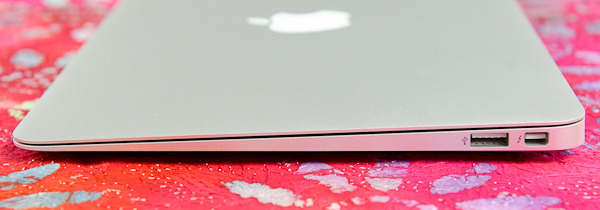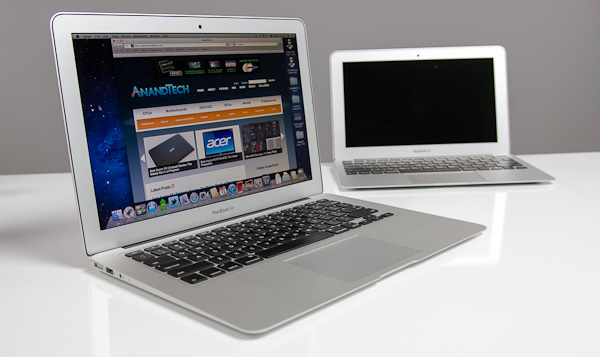The 2012 MacBook Air (11 & 13-inch) Review
by Anand Lal Shimpi on July 16, 2012 12:53 PM EST- Posted in
- Apple
- Mac
- MacBook Air
- Laptops
- Notebooks
Things are getting very blurry.
The MacBook Pro once stood for tons of power plus upgradability. Add a Retina Display and now it's just tons of power. It's a thicker, faster MacBook Air (with an awesome display). It's not bad, in fact it's quite amazing, but it confuses the general order of things.
The MacBook Air doesn't help in the clarity department. You can now order a MacBook Air with up to 8GB of RAM and a 512GB SSD, for the first time in MacBook Air history. Users who were once forced into Pro territory because of RAM and storage requirements can now happily live with an Air. And thanks to Turbo Boost, you do get similar performance in lightly threaded workloads.
Take a step away from the Mac world and you'll see the rest of the market is going through its own confusing period. Nearly every single Microsoft partner is mixing tablets and Ultrabooks. If your tablet uses smartphone hardware, and can dock into a notebook or Thunderbolt itself into a desktop, is all of this a lot of confusion before client computing moves entirely to smartphones? NVIDIA said it would happen publicly (even Intel did so privately a few years ago). Maybe it wasn't just convenient rhetoric. Maybe that's where we're headed. Until then, there are going to be a lot of different form factors, all with very compelling features. The MacBook Air continues to be one of them.
Despite the recent Ultrabook frenzy, the MacBook Air was one of the first (if not the first) to marry performance with usability, screen size/resolution, portability and battery life. Ultraportables prior to the MacBook Air's arrival in 2008 typically sacrificed in one or more of the above areas. I spent years in pursuit of the perfect ultraportable in college over a decade ago (30 is the new 20 right?), and generally came away disappointed and empty handed.
In 2010 Apple changed the expectations of cost with the MacBook Air. The new 11-inch model would start at just $999. And the 13-inch would only cost $300 more. The very first MacBook Air, by comparison, retailed for $1800. Apple took an ultraportable and made it its mainstream notebook. It was a bold move but one that was very forward looking.
Today the MacBook Air is even more affordable. The 11-inch model still starts at $999, but the 13-inch version is only $200 more. From the outside not a lot has changed, but that doesn't mean there's any less to talk about. Ivy Bridge, USB 3.0 and faster SSDs are all on the menu this year. Let's get to it.
The 11 & 13
Unlike the other thin member of Apple's Mac lineup, the MacBook Air chassis hasn't changed over the past three years. Since the 2010 update that gave us the 11-inch model and significantly lower prices, Apple has stuck with a design that only recently has seen widespread emulation.
While our last review focused on the beginning of a new generation, this review takes a look at a very mature, yet still very good design. The MacBook Air is just so pleasant to carry around. It'll make even the new rMBP feel like a pig.
Both the 11 and 13-inch models are effortless to carry around. While I dread traveling with a traditional notebook, slipping one of these into my backpack is barely noticeable. You can get used to and take for granted just about anything, but the form factor of the MacBook Air continues to be a favorite of mine even today.

The 11-inch MacBook Air is a great option for those who want the portability of a tablet but find themselves wanting to attach a keyboard to it most of the time. The 11.6-inch display boasts the highest pixel density of all of Apple's non-retina displays at 1366 x 768, but it's still quite usable. You don't make any sacrifices on keyboard size or key spacing (it's identical to the 13-inch model for the majority of the keys), nor do you have to give up any performance either. Apple offers all of the same CPU, memory and storage upgrades across both MacBook Airs. And with no discrete GPU, thermal throttling isn't really a problem either in the 11-inch chassis. With Thunderbolt, the 11-inch MacBook Air can actually give you the best of both worlds: an incredibly portable computer when you're on the go, and enough to act as your desktop when docked to a Thunderbolt Display.
I've traditionally always bought the 11-inch MacBook Air with the thought that I'd carry it when I didn't need to lug around my MacBook Pro. I seemed to be fooling myself however as over 90% of the time I'd end up with the MacBook Pro. The 11-inch Air was relegated to typewriter duty when I needed a change of scenery while writing at home. It's a great writer's companion, but if I couldn't have more than one system I'd have to opt for its bigger brother.
When I first reviewed the redesigned 13-inch MacBook Air I wrote that it felt more like a normal notebook, while the 11 was something a bit more unique. Perhaps I was more infatuated with the new 11 at the time, because these days I'm more drawn to the 13-inch MacBook Air as the notebook to have if you can only have one.
You get a 23.5% increase in screen resolution on a display that's just easier to look at. While 1440 x 900 is a bit much on a 15-inch MacBook Pro, I'd say it's near perfect on the 13-inch Air. If Apple were to do the Retina treatment on here, it'd be magnificent.
The larger chassis allows room for an SD card reader, which is thankfully quite functional. Otherwise the port layout is identical to the 11-inch model.
| 2012 MacBook Air Lineup | ||||||
| 11.6-inch | 11.6-inch (high-end) | 13.3-inch | 13.3-inch (high-end) | |||
| Dimensions |
H: 0.11-0.68" (0.3-1.7cm) W: 11.8" (30cm) D: 7.56" (19.2cm) |
H: 0.11-0.68" (0.3-1.7cm) W: 12.8" (32.5cm) D: 8.94" (22.7cm) |
||||
| Weight | 2.38 lbs (1.08kg) | 2.96 lbs (1.35kg) | ||||
| Cores/Threads | 1.7GHz dual-core Core i5 | 1.8GHz dual-core Core i5 | ||||
| Base Clock Speed | Intel HD 4000 | |||||
| RAM | 4GB DDR3L-1600 | |||||
| SSD | 64GB SSD | 128GB SSD | 128GB SSD | 256GB SSD | ||
| Display Resolution | 1366 x 768 | 1440 x 900 | ||||
| Ports | Thunderbolt, 2x USB 3.0, headphone jack | Thunderbolt, 2x USB 3.0, SD card slot, headphone jack | ||||
| Price | $999 | $1099 | $1199 | $1499 | ||
In its role as a proponent of simplicity, Apple has reduced the decision between what Air to get down to screen size, resolution and battery life (the 13-inch chassis houses a much larger battery). If you like having more of all of those things, the 13-inch Air is for you. If carrying anything larger than a tablet upsets you, buy the 11.




















190 Comments
View All Comments
name99 - Tuesday, July 17, 2012 - link
The most likely reason for the USB3 problems is devices that are just slightly out of spec, demanding more power than USB3 can deliver. The larger rMBP is willing to give them this extra power, the smaller MBAs cannot.This is a very common problem these days with flash storage. Look at a table of the power demands of various disks for either startup or sustained writes --- it is depressing how many are almost (but just over) the USB3 limit --- and there are plenty of manufacturers (yeah, OCZ, I'm looking at you) who are quite willing to sell you a "USB3" drive which kinda sorta appears to run until you generate a long series of sustained writes at which point it hangs.
So why does the failure for these drives appear at plugin time?
One possibility is that they need a burst of juice to start themselves going, another is that they negotiate with the host and can't negotiate as much power as they want. (I don't know the USB3 power negotiation protocol.)
It would be an interesting experiment, IMHO, for Anand to try the problematic devices again with a Y cable that could deliver extra USB power from a second port.
jospoortvliet - Wednesday, July 18, 2012 - link
On a related note - neither can anyone sell the nice magsafe(2) adaptors, it seems. Quite annoying - I don't really get why it's legal that Apple can stop others from making those? I get they have patents on it, but wasn't the idea of the patent system to ensure inventors get decently renumerated, not to let them block others from using their inventions? I thought you HAVE to license your patents for a 'reasonable' fee... Still, all other laptops come without a magsafe-like plug...Romberry - Tuesday, July 17, 2012 - link
...or drowning in Kool-Aid. Apple cripples other OS's on their hardware (and does so for no good technical reason at all.) See my previous comment for more. Or take a look at Ed Bott's recent article on another site concerning battery life on a Mac running Windows. Or fire up Google.KPOM - Tuesday, July 17, 2012 - link
Here's what Ed Bott said:"I don’t blame Apple for this terrible performance. They’ve focused their engineering resources on their own hardware and their own operating system. For Apple, Boot Camp is a tool to use occasionally, when you need to run a Windows program without virtualization software getting in the way."
It's always been obvious that Boot Camp drivers are subpar, though it is getting better. However, most people aren't buying Macs to run Windows as the primary OS. They do enough to get Windows running occasionally, but they rightfully spend their time and effort optimizing their hardware for OS X. What's the issue there?
Incidentally, the new Boot Camp drivers do enable AHCI support, so TRIM, etc. will work in Windows 7 and Windows 8. They also generally deliver decent performance (the Core i7 bug notwithstanding). Apple doesn't need to make Boot Camp available at all.
Spunjji - Tuesday, July 17, 2012 - link
No good technical reason, for sure. Business reasons, on the other hand... There are many people out there who don't get the technical side of it, they just get what works and what doesn't. They see Windows running poorly on the same hardware, so they assume that with all things being equal that Windows is the source of the problem. Makes a simple kind of sense unless you know that Apple are responsible for tying the 2 together. They could easily do it properly, but they never will. Because they're Captialist Pigs! Yaaayyy! :DFreakie - Tuesday, July 17, 2012 - link
Wait wut... Are you being sarcastic? o_O It's not Apple's choice to allow other OS's on their laptop, it's the hardwork of the programmers for the other OS's that allow their OS's to be compatible with an incredibly large range of hardware. Unlike OSX which can't even figure out it's own small range of hardware. It's out of Microsoft's own decision that it can run on non-partnered computers that you build yourself, or buy from a company that doesn't make Windows computers. In fact. Apple puts specific features in OSX to make it not run on any hardware but theirs and users have to hack in order to get it to run on anything else.Apple should be hanged for their nonexistent allowances of other OS's.
KPOM - Tuesday, July 17, 2012 - link
Uh, without Boot Camp, it would be very difficult to run Windows, because Windows doesn't support Apple's implementation of EFI (which predates Windows' support for UEFI). Also, they do write drivers for their components. Microsoft's stock drivers don't support all the hardware used.Freakie - Tuesday, July 17, 2012 - link
Yes, Microsoft uses a new, more advanced, and completely 64bit compatible version of EFI. Just because Apple did it first, doesn't mean they somehow do it better now xP Though from what I've seen, the ability to put Windows on a Mac without any modifications isn't a fault of Windows, but differences between the two OS's as well as Apple's insistence of only allowing Windows on their system under their own terms. If Apple was more open about things, then hackers would have had to work less =PI also never said they didn't write their own drivers? o_O I mean, they obviously don't write all of their own drivers 100%, as I am sure that the hardware manufacturers have to give them something to start with.
And Microsoft's stock drivers are actually quite impressive. Of course they can' support every little peripheral, but they do an amazing job of supporting a countless range of combinations of hardware. There is no doubt that Microsoft's view on how it develops drivers is much more open than Apple's. Microsoft support DIY builders and system integrators as well, while Apple does not.
KPOM - Tuesday, July 17, 2012 - link
Boot Camp came out before Windows supported EFI at all. Apple has no real incentive to switch to UEFI because it doesn't really offer significant benefits, and they'd have to modify UEFI anyway to keep OS X proprietary.My point wasn't about UEFI, though. It is about Apple enabling other operating systems to run on their computers. They actively added that capability when they didn't need to.
Your point about MS' openness vs. Apple is well known. Microsoft is primarily a software company. Up to now, they haven't cared whether you installed Windows 7 on an Apple, a Dell, HP, or something you built yourself. However, with Windows RT, they are going partly the Apple route, since they won't sell the OS separately, and will individually approve manufacturers and designs. So apparently even they recognize there are advantages to a closed model.
Spunjji - Tuesday, July 17, 2012 - link
"When they didn't need to" <- What nonsense is this? A market requirement translates as a need. They would have lost all of the customers out there who require genuine Windows applications running under non-virtualised Windows. This is a non-trivial portion of the market.Apple do not do anything out of the generosity of their hearts. What wealthy company does?